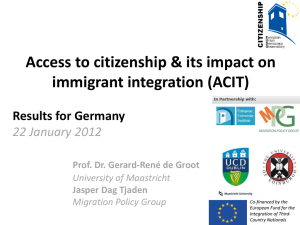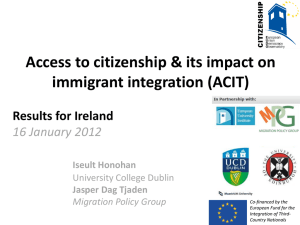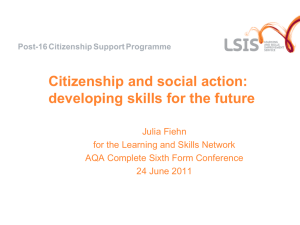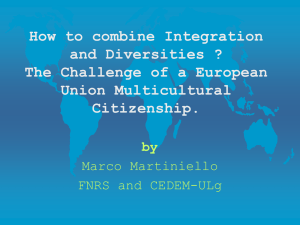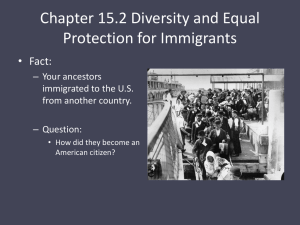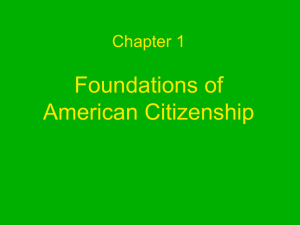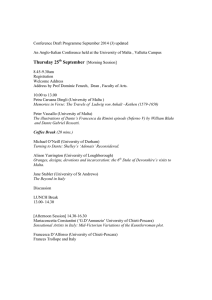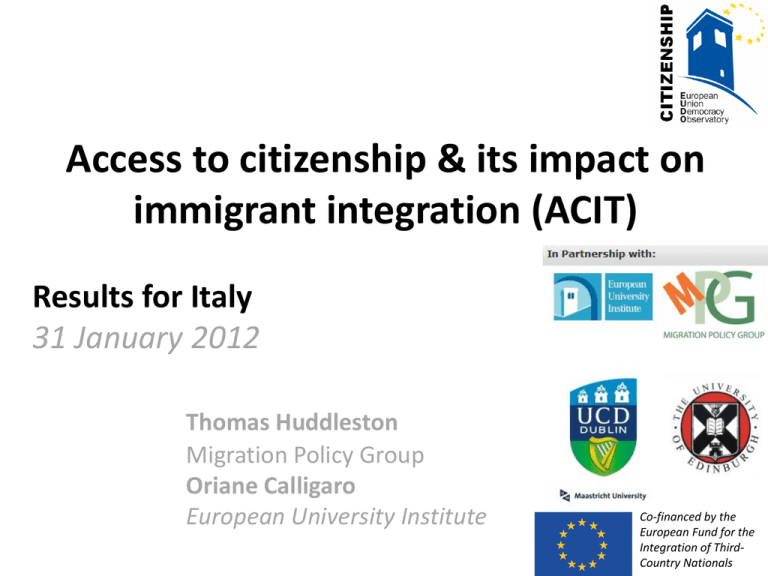
Access to citizenship & its impact on
immigrant integration (ACIT)
Results for Italy
31 January 2012
Thomas Huddleston
Migration Policy Group
Oriane Calligaro
European University Institute
Co-financed by the
European Fund for the
Integration of ThirdCountry Nationals
Access to citizenship & its impact on
immigrant integration (ACIT)
http://eudo-citizenship.eu
End date: 31/03/2013
Goal: Researchers & policy actors better understand how law, implementation, and other
factors affect citizenship acquisition and how citizenship affects integration processes;
Goal: Policymakers & civil society use evidence to design more effective laws and measures
Consolidate law indicators
Pilot implementation indicators
Expand ‘outcome’ indicators
Assess determinants of naturalisation across EU
Assess citizenship impact on integration process
10 national citizenship dialogues and national handbooks
EU conclusions, recommendations, dialogue, module
Citizenship Law Indicators
(CITLAW)
• 57 indicators compare specific aspects of citizenship regimes
across countries and time
– basic indicators (e.g. Ius Soli for second generation)
– several combined indicators (e.g. Ius Soli at birth)
– six combined indicators: ius sanguinis, ius soli, ordinary
naturalisation, special naturalisation, renunciation,
withdrawal
• Indicators measure strength of the purpose or principle of the
citizenship law
• Indicator scores range from 0 to 1
0 = purpose/principle not represented
1 = purpose/principle strongly represented
Summary of Findings
Ius Sanguinis
0.9
0.8
0.7
0.6
0.5
0.4
0.3
0.2
0.1
0.0
Renunciation
Ius Soli
Involuntary Loss
Ordinary Naturalisation
Special Naturalisation
Italy
EU-15
EU-27
Ordinary Naturalisation
1.0
0.9
0.8
0.7
0.6
0.5
0.4
0.3
0.2
0.1
0
0.0
Overall
Residence
Conditions
Renunciation
Foreign
Citizenship
Italy
Language
Conditions
EU-15
Civic Knowledge / Criminal Record
Assimilation
EU-27
Economic
Resources
Ordinary Naturalisation
opportunities
obstacles
• Dual nationality accepted • Very restrictive residence
requirement (10 years
• Flexible criminal record
uninterrupted with LTR)
requirement
–
–
–
–
EU-15
EU-27
Italy
Switzerland
0.61
0.55
0.26
0.12
• Demanding economic
resources requirement
Special Naturalisation (selected modes)
1.0
0.9
0.8
0.7
0.6
0.5
0.4
0.3
0.2
0.1
0.0
Italy
EU-15
EU-27
Special Naturalisation
obstacles
opportunities
• socialisation-based access
• Spousal transfer
for foreign-born children
• Child extension
• Reacquisition
• Shorter periods for EU citizens,
refugees, & stateless
Citizenship Implementation
Indicators (CITIMP)
• 38 indicators compare formal aspects of naturalisation procedure.
These include all stages, from efforts by public authorities to
inform applicants to the options to appeal a negative decision.
• 5 dimensions covered administrative procedure:
1) Promotion: how much do authorities encourage applicants to apply?
2) Documentation: how easily can applicants prove they meet the conditions?
3) Discretion: how much room do authorities have to interpret conditions?
4) Bureaucracy: how easy is it for authorities to come to a decision?
5) Review: how strong is judicial oversight of the procedure?
Summary of Findings
Generally, countries with many legal obstacles (CITLAW) have many
procedural obstacles (CITIMP)—Italy has some of greatest procedural obstacles
IT procedure most unfavourable in EU15
• Least done to promote naturalisation in EU15
• Most demanding documentation of any EU country
• Discretionary and one of the most bureaucratic in EU
• Basic judicial review (e.g. reasoned decision and appeal)
Promotion
Italy does least to promote naturalisation than any other EU15 country
Opportunities:
• Very basic national website, local ceremonies, & local campaigns in a few cities
‘Missed’ opportunities:
• No national campaign, information service, promotional materials, quality website, state
actions targeting the general public
• Comparatively high fees without legal right to exemption
• Ceremonies do not involve media
Documentation
Documentation in IT is more demanding than any other EU country
Obstacles:
• Discretionary language and integration assessment
• Several years’ proof of documentation on residence/ID and income
• No clear alternative means to prove identity
• Additional paperwork on identity from country of origin (legalisation, translation)
• Documentation required on criminal record from country of origin
Bureaucracy
Procedure in Italy is more bureaucratic than in any other EU15 country
Obstacles:
• Different authorities receive the application (Prefect), checks the documents (Police) and
decide on the application (Interior Ministry)
• Many other ministries and agencies also involved in checking and decision
• Legal time limits without sanctions
Citizenship acquisition
(CITACQ)
• Acquisition indicators compare rates of citizenship
acquisition among foreign-born in their country of residence
• Percentages of foreign-born immigrants who have acquired
citizenship at any point in time, not naturalisation rates
measuring the number of new naturalisations divided by
resident population with foreign citizenship
• Information based on European Labour Force Survey Ad Hoc
Module (2008) that targets immigrants and their
descendants, aged 15-67
• Data exclusively on foreign-born (1st generation) and allows
for comparisons of citizenship acquisition rates across 25
European countries
Citizenship acquisition
(CITACQ)
Includes information on the following indicators for
citizenship acquisition by foreign-born:
–
–
–
–
ALL
SEX (female vs. male)
ORIGIN (EU vs. non-EU countries)
AGE AT MIGRATION (age at which respondent took up
residence)
– YEARS OF RESIDENCE (years of residence)
– YEARS OF RESIDENCE (minimum number of years of
residence)
– TIME UNTIL NATURALISATION (numbers of years until
naturalisation)
Summary of Findings
• On average around 34% of foreign-born persons are a
citizen of their EU-15 country of residence.
– Citizenship acquisition rates in EU-15 range are lowest in
Luxembourg (10%) and highest in Sweden (67%). In Italy, the
acquisition rate (17%) is below average.
– Immigrants from non-EU countries (42%) more often acquire
citizenship than those from EU countries (20%).
• On average it takes around 10 years for foreign-born
persons to acquire citizenship of their country of
residence, within EU-15 countries.
– In Luxembourg it takes almost 15 years on average to
naturalise, whereas in Ireland this is around 5 years. In Italy
the speed (8 years) is below the EU15 average
– In Italy, relatively few who naturalise do so rather quickly
(e.g. due to marriage, see female rates)
Acquisition rates in EU-15 (+CH, NO)
Italy
Speed of naturalisation
Italy
Italy compared I
(% foreign-born with citizenship)
45
Italy
EU-15
42,04
40
35,67
34,43
35
33,02
30
25
21,54
%
21,20
20,48
20
16,67
15,08
15
10,26
10
5
0
ALL
SEX (female)
SEX (male)
ORIGIN COUNTRY
(EU)
ORIGIN COUNTRY
(non-EU)
Italy compared II
(% foreign-born with citizenship)
70
Italy
EU-15
60
50
40
%
30
20
10
0
at least 5 years
at least 10 years
at least 15 years
years of residence
at least 20 years
Analysis of acquisition rates
Citizenship acquisition & speed of acquisition are mainly driven by:
• Socio-economic development of countries of origin
• Citizenship laws of the country (see following graph)
Variation in acquisition rates is mainly explained by:
• Marital status (married people are more likely to be naturalised)
• Socio-economic status (employed immigrants are more likely)
• Gender (female immigrants are more likely)
• Use of native language at home (immigrants who speak the
language of the destination country at home are more likely)
Predicted probability of having destination country citizenship
by MIPEX Access to Nationality
(by years of residence in country)
Italy
(MIPEX’ = 56)
Italy
(MIPEX’ = 56)
MIPEX Access to Nationality score (adjusted for first generation only)
Citizenship and Integration (CITINT)
• 10 core indicators measure the the extent to which
changes in citizenship status affect levels of integration
• Three categories of indicators:
– Labour force participation (2008 Eurostat LFS ad hoc
module)
– Social exclusion (2008 Eurostat LFS ad hoc module &
2008 EU-SILC)
– Living conditions (2008 EU-SILC)
• Sample: EU-27, Iceland, Norway, Switzerland
• As expected, immigrants who naturalised are often
better off than immigrants who have not naturalised.
Labour Force Participation
Unemployment Rates, 2008 (%)
12
10
8
6
4
2
0
Italy
EU-15
Natives
Naturalised Immigrants
EU-27
Non-citizen Immigrants
Source: 2008 EU Labour Force Survey Ad Hoc Module
Labour Force Participation
Overqualification Rates, 2008 (%)
70
60
50
40
30
20
10
0
Italy
EU-15
Natives
Naturalised Immigrants
EU-27
Non-citizen Immigrants
Source: 2008 EU Labour Force Survey Ad Hoc Module
Social Exclusion
Share With Difficulty Making Ends Meet, Italy, 2008 (%)
Natives
Naturalised Immigrants
Non-citizen Immigrants
0
10
20
30
40
Non-EU
50
60
70
80
90
100
EU
Source: 2008 EU-SILC Survey
Living Conditions
Housing Cost Burden, 2008 (% of monthly income)
35
30
25
20
15
10
5
0
Italy
EU-15
Natives
Naturalised Immigrants
EU-27
Non-citizen Immigrants
Source: 2008 EU-SILC Survey
Conclusions
Major legal opportunities
• Dual nationality • Facilitated naturalisation for refugees, stateless, EU citizens
Major legal obstacles
• Long & discretionary naturalisation • Weak ius soli • No socialisation-based access
Major administrative opportunities
• Basic judicial review • Some guidance to interpret discretionary requirements
Major administrative obstacles
• Least on promotion • Most bureaucratic • Most demanding documentation
•
•
•
•
•
Citizens of EU & other highly-developed countries less likely to naturalise
Non-EU citizens are more likely to naturalise, as newcomers settle long-term
The relatively few foreign-born able to naturalise in IT could do so quickly
Still, IT has below-average naturalisation rates—policies have had major impact
IT’s many legal and procedural obstacles discourage foreigners from applying

